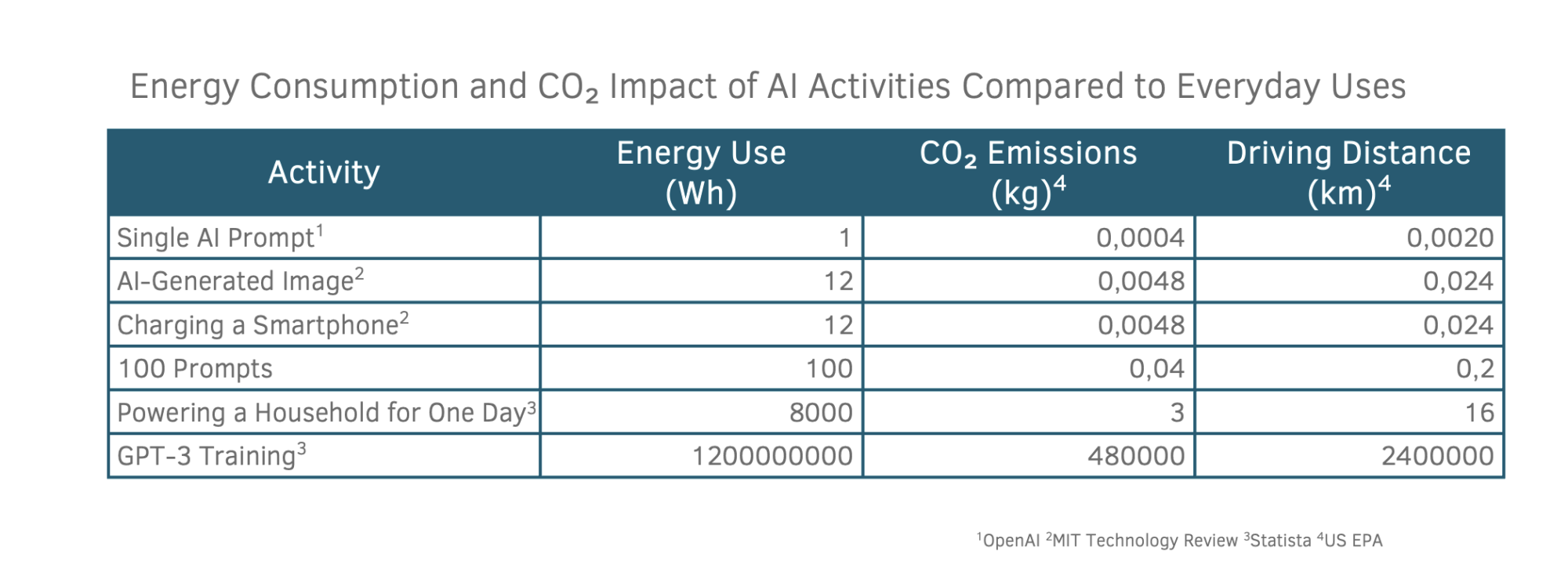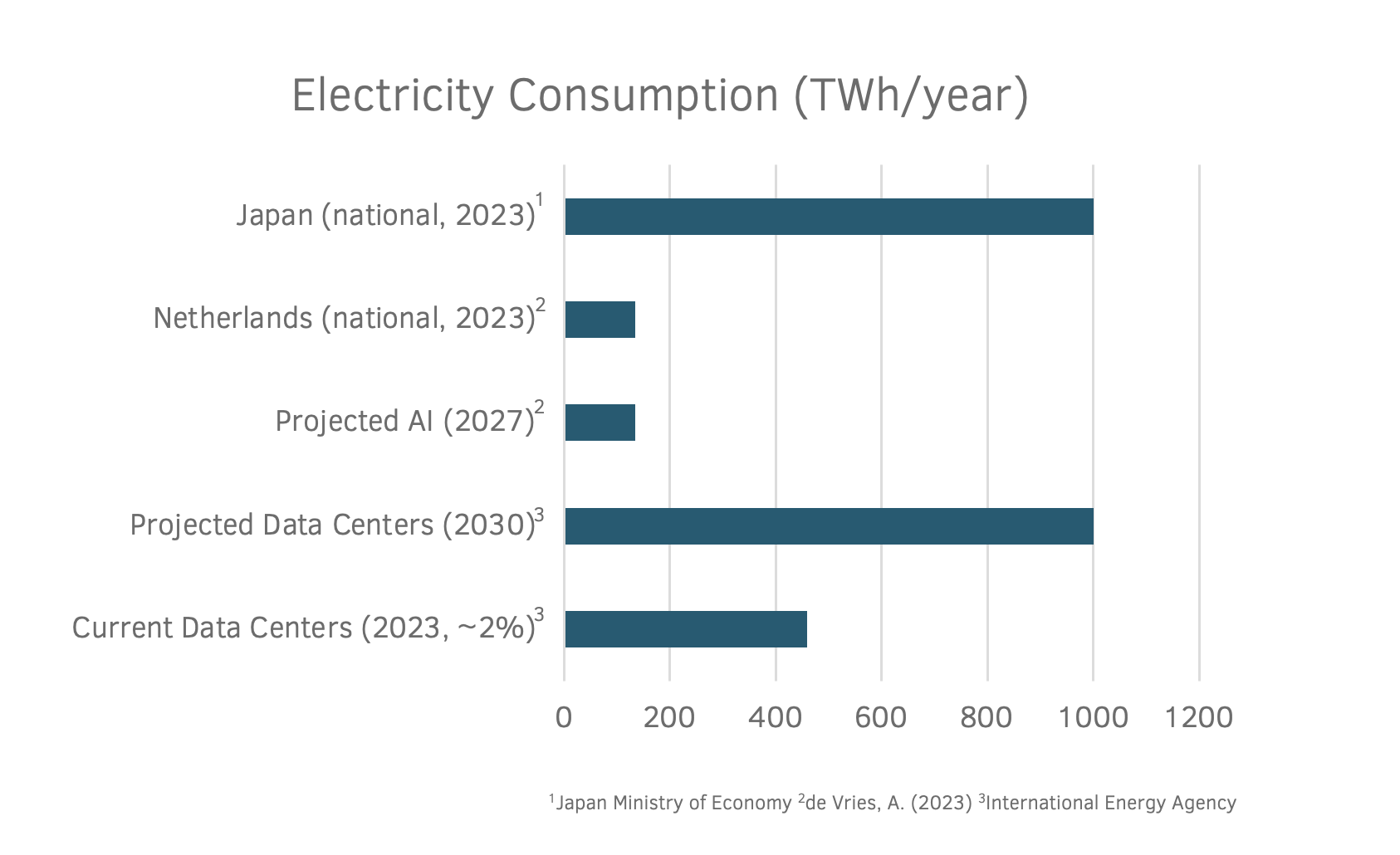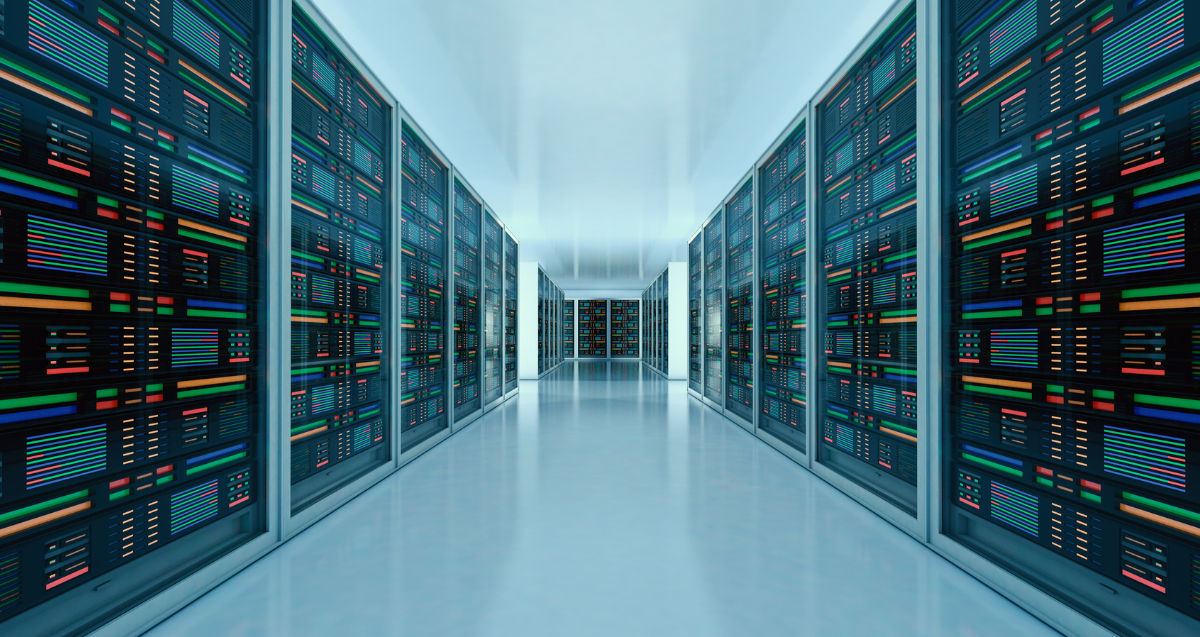Artificial intelligence (AI) is no longer futuristic—it’s embedded in our daily routines. Whether it’s asking ChatGPT for a quick summary, receiving personalized shopping suggestions, or having customer queries resolved by chatbots, AI is quietly transforming how we live and work. It’s woven into sectors from healthcare to transportation, unlocking efficiencies, automating decisions, and amplifying productivity.
But beneath this smooth and seamless experience lies a much less visible cost: energy.
The Hidden Energy Footprint of Everyday AI
While AI may feel intangible, it is underpinned by a massive physical infrastructure. Data centers filled with high-performance processors handle the intense computational demands of AI models. The more advanced the model, the greater the power required, especially during training.
To put this into perspective, training a single large-scale model like OpenAI’s GPT-3, which consumes around 1,200 MWh¹, uses more electricity than a medium-sized nuclear power plant typically generates in an hour—around 1,000 MWh². For further context, the average European household consumes just 3 MWh3 per year, making GPT-3’s training equivalent to the annual energy use of around 400 homes.
Even everyday interactions aren’t energy neutral. For example:
Generating one AI image can use as much electricity as charging a smartphone, around 12 Wh4
A single prompt to a large language model like GPT-3 can consume around 1 watt-hour – less than boiling a kettle, but significant when scaled across around 400 million weekly users of ChatGPT9
These may seem like small figures in isolation, but the scale and frequency of AI usage make them substantial contributors to electricity demand.

Rising Demand Meets Efficiency Gains
AI’s trajectory is clear: more adoption, across more sectors, at greater scales. By 2027, AI is projected to consume up to 134 TWh annually, equivalent to the total electricity consumption of a nation like the Netherlands5. Moreover, data centers, which currently account for around 2% of global electricity demand, are expected to surpass 3% by 20306—amounting to around 1,000 TWh annually, roughly equivalent to Japan’s entire electricity consumption in 20237.

The good news is that AI hardware is improving. Innovations like NVIDIA’s energy-efficient superchips and more effective cooling systems could reduce the energy required for individual tasks by up to 25 times. The shift toward smaller, task-specific models, driven in part by DeepSeek and its recent media attention, is leading to significant efficiency gains over traditional monolithic models.
However, these technological improvements may not offset the overall rise in demand. As AI becomes more ubiquitous – from real-time language translation to predictive analytics in industrial systems—total energy consumption will likely continue to grow.
Strategic Implications for the Energy Sector
This evolving landscape presents both a challenge and an opportunity for energy-related industries.
On the opportunity side, AI-driven growth in electricity demand opens the door to innovation in energy generation, transmission and storage. There is growing alignment between AI workloads and the push toward renewable energy expansion. Solar and wind can be paired with large-scale battery storage systems to support the fluctuating demands of AI-intensive data centers.
However, infrastructure must keep pace. Traditional power grids may face increased strain from dense, localized demand hubs created by AI data facilities. The pressure to simultaneously decarbonize the grid while supporting accelerating consumption adds further complexity.
Yet AI is not just a driver of demand, it can be part of the solution. AI tools are already being used to optimize grid operations, forecast energy usage, and improve demand-side efficiency. Energy companies that adopt AI internally may not only reduce their own emissions but also improve resilience and cost-effectiveness.
Positioning for a Sustainable Future
As AI reshapes the energy landscape, energy-related companies must think beyond short-term adjustments. This is not just a technological evolution – it’s a structural shift that demands proactive, sustainability-minded strategies.
Invest in renewable capacity and grid modernization to accommodate rapidly evolving and increasing AI-driven energy loads
Collaborate with technology companies to co-design solutions that align AI growth with environmental responsibility and long-term resilience
Anticipate shifts in consumption patterns, both from industry and individual users – and build capabilities that adapt with agility and insight
Crucially, those who succeed will be the ones who integrate sustainability into their growth models – leading not just in energy supply, but in shaping the digital backbone of an AI-powered future.
Conclusion: The Energy–AI Nexus
AI is a generational technology. Its promise – to boost efficiency, intelligence, and responsiveness – is already transforming the way industries operate and individuals interact with digital systems. But this intelligence comes with a physical cost. We must bring greater awareness to that cost. Every image generated, query answered, or model trained consumes electricity – often invisible to the end user. As the demand for AI services grows, so does the responsibility to understand and manage their environmental impact.
There are tools emerging that help compare the energy usage of different AI models and applications, offering both developers and users clearer insights into their digital footprints. Encouraging this kind of transparency and digital energy literacy is key to fostering responsible AI use at every level.
The dual challenge is clear: how do we harness the societal benefits of AI without undermining our environmental goals? For energy players—and indeed for users, developers, and regulators—the answer lies not in resistance, but in shaping the wave. With foresight, collaboration, and a shared commitment to sustainability, we can ensure that power fuels possibility, not just consumption.
Looking for deeper insights?
1 Statista
2 US Department of Energy
3 Statista
4 MIT Technology Review
5 de Vries, A. (2023). Joule
6 International Energy Agency (IEA)
7Japan Ministry of Economy, Trade and Industry
8 NVIDIA
9 OpenAI

 ISO/IEC 27001:2013 certified
ISO/IEC 27001:2013 certified